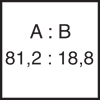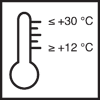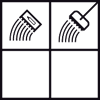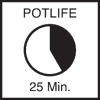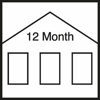Article No. 668726
ESD-compliant coating


Product specifications
Component A
Component B
Mixture
(DIN EN 51130:2014) R9 (level of blinding 10% Mica GHL 3/0) R10 (level of blinding 20% Mica GHL 3/0)
Once fully cured
* Fire test class in defined systems (see test report on fire classification: Remmers conductive systems)
The stated values represent typical product characteristics and are not to be construed as binding product specifications.
Field of application
- Self-levelling coating for ESD protected areas
Properties
- Dissipative / ESD-compliant
- Volume conductive when used in a system
- Resistant to mechanical and chemical loads
- Coating compatibility test
- Free from solid salts and aqueous salt solutions
- Suitable for hand pallet trucks and forklift trucks
- Physiologically harmless once fully cured
-
Preparation
-
Substrate requirements
The substrate must be firm, dimensionally stable, capable of bearing loads and free of loose constituents, dust, oil, grease, rubber marks and other substances that could interfere with adhesion.
Suitable Remmers epoxy primers, epoxy scratch coats or epoxy mortars must always be used.
-
Preparations
Before the application of the product a smooth surface must be produced, e.g. with a scratch coat.
Refer to the current Technical Data Sheet for detailed information on the single products.
Always apply Epoxy Conductive LE / VDE as a transverse conducting layer in accordance with the current Technical Data Sheet.
-
-
Preparation
-
Combination container
Add the entire quantity of the hardener (component B) to the base compound (component A).
Mix thoroughly with a slow-speed electric mixer
(approx. 300 - 400 rpm).Mix for at least 3 minutes.
Insufficient mixing is indicated by streaks forming.
-
Application
-
As a general principle, higher temperatures will reduce and lower temperatures will increase the times stated.
-
Working tools / cleaning
-
Notched trowel, notched scraper, mixer, spiked roller
-
More detailed information can be found in the Remmers Tool Programme.
Clean tools, equipment and splashed material immediately while fresh with V 101.
Take suitable protective and waste disposal measures when cleaning.
-
Storage / shelf life
-
If stored unopened in the original container and kept cool, dry and protected from frost, min. 12 months (component A)/min. 24 months (component B).
-
Usage
-
See application examples
-
-
Application examples
-
Application Degree of filling with Selectmix 01/03 Binder application rate [kg/m²] Mixture application rate [kg/m²] Toothed blade Application rate per mm coating thickness [kg/m²] Coating approx. 1.1 mm unfilled 1.8 - No. 46 1.50 Filled coating 1 : 0.3 min. 1.8 min. 2.4 No. 48 1.55 -
C
Pour the material onto the prepared substrate and then distribute using a suitable tool, e.g. a notched trowel or notched scraper.
Afterwards roll over with a (metal) spiked roller.
(see table)
-
FC
Pour the material onto the prepared substrate and then distribute using a suitable tool, e.g. a notched trowel or notched scraper.
Afterwards roll over with a (metal) spiked roller.
(see table)
-
BLFSL
Broadcast an excess of suitable silicon carbide or Ceramix Conduct 04/08 into the wet base layer.
approx. 1.4 kg/m² binder and
5 - 6 kg/m² Ceramix Conduct 04/08 -
HS
Pour the material onto the prepared surface, spread evenly using a rubber scraper, then roll crossways using a suitable epoxy roller.
approx. 0.6 - 0.7 kg/m² binder
-
-
General information
-
Unless otherwise specified, all of the values and application rates given above have been determined under laboratory conditions (20 °C) using standard colours. Slight deviations from these values may arise if the product is worked with on site.
Before the application of the covering layer, the correct functioning of the transverse conducting layer and of the connections must be proved and registered in a measurement report.
When coating continuous surfaces, only use materials with the same batch number as slight differences in colour, gloss and texture may occur.
Due to the black transverse conducting layer, poorly covering colours are not to be used.
When used as a top seal, the inherent colour of the granules may limit the opacity of light shades.
Low levels of air humidity can cause a higher discharge resistance, uneven or thicker layers can even lead the coating to not be conductive at all.
Before checking the ESD values, we recommend cleaning the ESD shoes, the electrodes and the floor coating with isopropyl alcohol or ethanol (95%) and waiting until it has evaporated.
In case of possible permanent exposure to water or prolonged accumulations of moisture, the formation of white stains on the surface is possible. This does not affect the technical properties of the coating.
Low thickness and low temperature can affect the visual effect of the finished surface.
Abrasive mechanical loads leave traces of wear.
Exposure to vehicles with metal or polyamide tyres as well as dynamic concentrated loads can cause faster wearing of the coating.
Epoxy resins are generally not colourfast when exposed to UV light or weather.
In case of repairs on the surface or working up to existing surfaces, there will be a visible transition in appearance and texture.
Further notes on working, system construction and maintenance of the listed products can be found in the latest Technical Data Sheets and the Remmers system recommendations.
-
-
Disposal instructions
-
Larger quantities of leftover product should be disposed of in the original containers in accordance with the applicable regulations. Completely empty, clean containers should be recycled. Do not dispose of together with household waste. Do not allow to enter the sewage system. Do not empty into drains.
-
-
Safety / regulations
-
For professional users only!
For further information on the safety aspects of transporting, storing and handling the product and on disposal and environmental matters, please see the current Safety Data Sheet and the brochure entitled "Epoxy Resins in the Construction Industry and the Environment", issued by Deutsche Bauchemie e.V. (3rd edition 2022).
-



